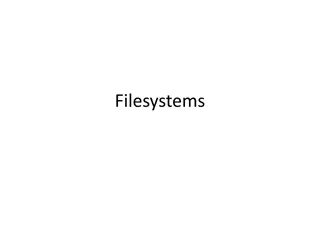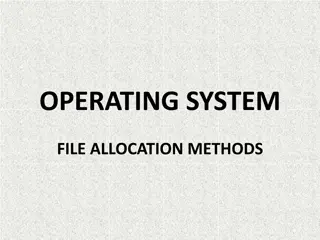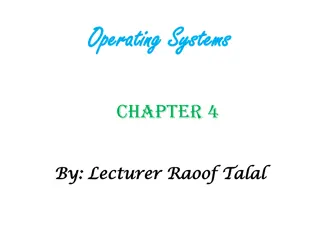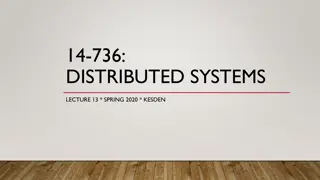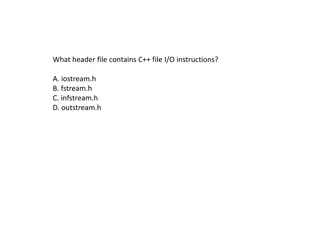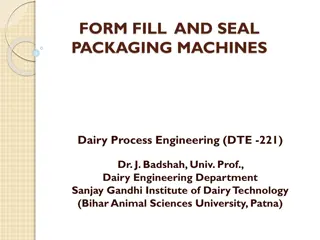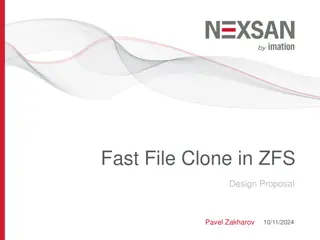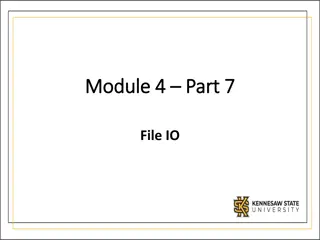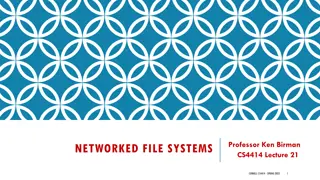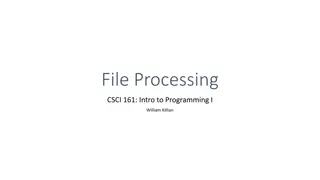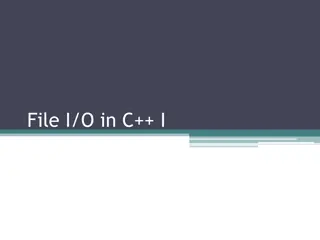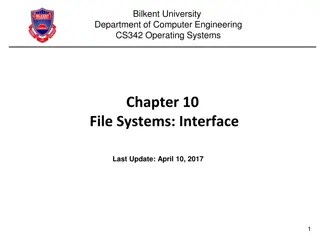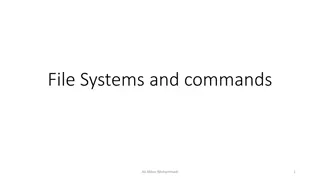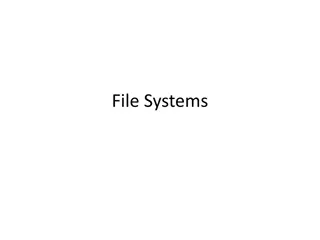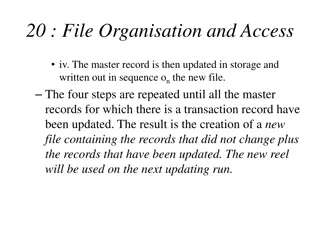FFS: The Fast File System
The Fast File System (FFS), discussed in CS 161 Lecture, aims to enhance the performance of file system implementations while maintaining existing abstractions. It introduces concepts like disk stripe layouts, data allocation strategies, and block size optimization to reduce mechanical delays and improve disk access efficiency. FFS addresses limitations of traditional UNIX file systems, such as poor block allocation and suboptimal disk layout, by leveraging disk-aware file placement and larger block sizes. By optimizing data distribution and minimizing seek operations, FFS significantly boosts disk bandwidth utilization and enhances overall system performance.
Download Presentation

Please find below an Image/Link to download the presentation.
The content on the website is provided AS IS for your information and personal use only. It may not be sold, licensed, or shared on other websites without obtaining consent from the author.If you encounter any issues during the download, it is possible that the publisher has removed the file from their server.
You are allowed to download the files provided on this website for personal or commercial use, subject to the condition that they are used lawfully. All files are the property of their respective owners.
The content on the website is provided AS IS for your information and personal use only. It may not be sold, licensed, or shared on other websites without obtaining consent from the author.
E N D
Presentation Transcript
FFS: The Fast File System CS 161: Lecture 13 3/30/17
The Original, Not-Fast Unix Filesystem Disk Superblock Superblock wide metadata like the size of disk blocks, and the start offsets for the inode section and data section Inode Metadata Direct ptr . . . Contains file system- Inodes Indirect ptr . . . Data 2-indirect ptr . . . Directory Data Name i-number
The Original, Not-Fast Unix Filesystem Disk Design: Disk is treated like a linear array of bytes Problem: Data access incurs mechanical delays! Accessing a file s inode and then a data block requires two seeks (or more if the block is indirectly-pointed-to) Block allocation wasn t clever, so files in the same directory were often far apart Block size was 512 bytes, increasing penalty for poor block allocation (more disk seeks!) Result: File system provided only 4% of the sequential disk bandwidth! Superblock Superblock Inodes Inode for file X DirEntry: X --> inode# Data Data block for X
FFS: The Fast File System Goal: Keep the same file system abstractions (e.g., open(), read()), but improve the performance of the implementation First idea: Increase block size from 512 bytes to 4096 bytes Increases min(bytes_returned_per_seek) --> decreases number of seeks 8x as much data covered by direct blocks --> fewer indirect block accesses --> decreases number of seeks Second idea: Disk-aware file layout Consider disk geometry and mechanical delays when deciding where to put files Keep related things next to each other to reduce seeks
FFS: Data Layout Spindle R/W heads Platter
FFS: Data Layout Track Cylinder Cylinder group
FFS: Data Layout Directory allocation: Use a cylinder group with few allocated directories and many free inodes File allocation: Allocate file inodes in cylinder group of parent directory; allocate file data blocks in cylinder group of file inode Allocation policies driven by expectation of temporal locality Files in the same directory will be accessed together (e.g., source code compilation, a browser s web cache) Providing spatial locality for data with temporal locality decreases disk seeks! Superblock Superblock Inode Inode bitmap bitmap Data bitmap Data bitmap Inodes Data Cylinder group
FFS: Data Layout OS wants to read 0 and 1, but disk only allows one outstanding request . . . Sequential file scan incurs rotational latency for each block! Request 0 Return 0 Request 1
FFS: Data Layout OS wants to read 0 and 1, but disk only allows one outstanding request . . . FFS determines the number of skip blocks by empirically measuring disk characteristics Request 0 Return 0 Request 1
Block Placement Tricks: Still A Good Idea? Modern disks are more powerful than FFS-era disks Use hardware-based track buffer to cache entire track during the read of a single sector Buffer writes, and batch multiple sequential writes into single one Keep a small reserve of extra physical sectors so that bad sectors can be avoided (disk implements a virtual-to-physical mapping!) Modern disks don t expose many details about geometry Only guarantee that sectors with similar sector numbers are probably close to each other w.r.t. access time So, modern file systems use block groups instead of cylinder groups . . . . . . . . . . . . . . . . . . CG #0 CG #1 CG #2
Ensuring Consistency After Crashes Q: What happens to on-disk structures after an OS crash or a power outage? A: The file system must recover to a reasonable state Some data loss is ok . . . . . . but it s NOT ok to have an unmountable file system! So, file system *metadata* must be consistent post-crash There s a trade-off between performance and data loss
Crash Consistency: Creating a New File To create a new file foo , you need to write three things to disk: 1. Update on-disk inode bitmap to allocate a new inode 2. Write the new inode for foo to disk 3. Write updated version of the directory that points to the new inode The order of the writes makes a difference! Suppose (1) has completed . . . how should we order (2) and (3)? Directory bar Inode #X Inode #X foo Inode #Y Directory bar Directory bar Inode #X foo Inode #Y Points to sadness Crash! Directory bar Inode #X Directory bar Inode #X Directory bar Inode #X Inode #Y Metadata DataPtrs=NULL Inode #Y Metadata DataPtrs=NULL Crash! (storage leak!) ^ Not referenced by a dirent . . . but no dirents point to junk/old stuff! After crash, we need to find unreferenced inodes and mark them as unused.
Why Is Crash Consistency Hard? We want to atomically move the file system from one state to another, but . . . A single, high-level file system operation like create a new file often corresponds to multiple disk writes, but the machine may crash without completing all writes The file system may issue writes to disk asynchronously, to allow processes to continue execution immediately after issuing IOs Ex: FFS would only flush data once every 30 seconds unless explicitly asked via a sync() request To improve performance, the hard disk may complete writes in a different order than they were generated! Ex: If the hard disk receives w0 (whose destination is far from the current position of the disk head), and w1 (whose destination is nearby), the disk may write w1 first
fsck: When Bad Things Happen To Good People In FFS, the fsck ( file system checker ) tool must be run after a crash to restore the file system to a consistent state Consistent is defined as all metadata is in agreement (e.g., no block that is marked as unallocated is referenced by an inode) This definition of consistent is NOT the same as all writes which made it to the disk pre-crash must be reflected in the post-crash file system in other words, fsck may discard some write data fsck is run on the file system before the file system is mounted, i.e., before the file system can be accessed by other applications
fsck: When Bad Things Happen To Good People Ex: Appending to a file via a direct pointer requires three disk writes (1) inode (to update data pointer, file size, last update time) (2) data block bitmap (to indicate that a new data block has been allocated) (3) the data block itself Suppose that writes (1) and (3) complete, but (2) doesn t Inconsistency: inode points to a valid data block, but the block bitmap wasn t updated, so the new data block isn t marked as in-use fsck resolves block bitmap inconsistencies by treating inodes as ground truth When fsck starts, it initializes the bitmap to all unallocated Start from root directory, fsck recursively scans all inodes, and marks all reachable data blocks as allocated in the bitmap At the end of a fsck, metadata is always consistent, but file *data* may contain junk! Ex: Writes (1) and (2) complete, but not (3)
fsck: When Bad Things Happen To Good People Besides fixing the data block bitmaps, fsck does a bunch of other checks Ex: An inode s link count refers to the number of directory entries that refer to inode (the number may be higher than 1 due to hard links) fsck traverses the entire file system, starting from the root directory, updating each inode s link count Disadvantages of fsck Implementing fsck requires deep knowledge of the file system: the code is complicated and hard to get right fsck is very slow, because it requires multiple traversals of the entire file system! Ideally, the recovery effort should be proportional to the number of outstanding writes at the time of the crash Journaling achieves this goal!
Sector Sizes From the perspective of an OS, a storage device is a big, linear array of bytes Sector: Smallest amount of data that the device can read or write in a single operation Up until 2011, hard drives used a sector size of 512 bytes Sync (helps with disk head timing timing alignment) helps detect misstepped head in wrong location) Address mark (contains sector # and cylinder #; Inter-sector gap Error-correcting code Data (512 bytes) 50 bytes 15 bytes
Sector Sizes As areal bit densities increased (i.e., as a 512 byte sector decreased in size), media defects of a given size caused increasingly larger damage A standard 512 byte sector could usually only correct defects of up to 50 bytes Smaller sector Post-2011, all commodity hard disks had transitioned to 4K sector sizes with 100 bytes of ECC (but 15 bytes of preamble, as in 512 byte sectors) 100 bytes of ECC per 4K sector can correct up to 400 bytes of error
Older/poorly-written software assumes a sector size of 512 bytes, so modern hard drives provide a backwards compatibility mode Two definitions for a sector Physical: Smallest amount of data that the device can read or write in a single operation Logical: Smallest amount of data that software can ask the device to read or write A drive with 4K physical sectors can advertise a logical sector size of 512 bytes This hack will keep cranky software happy . . . . . . but a write that is smaller than the physical sector size will result in a read-modify- write :-( Poor use of space :-(
Suppose that physical sectors are 4K bytes, logical sectors are 512 bytes, and the OS wants to write 512 bytes . . . 512 B logical sector to write Step 1: Hard disk reads entire 4 KB physical sector into on-disk cache 4KB physical sector in cache Step 2: Disk updates the logical sector in the cache Step 3: Disk rewrites modified physical sector to the platter
Write amplification: A single write requires additional reads or writes! To avoid write amplification, the OS should avoid writes that are smaller than the physical sector size The OS should also ensure that its data structures are properly aligned Ex: The file system should allocate data blocks such that: The size of each data block is evenly divisible by the size of a physical sector The start of each data block is aligned with the start of a physical sector Ex: Each swap file entry should be aligned with the start of a physical sector




